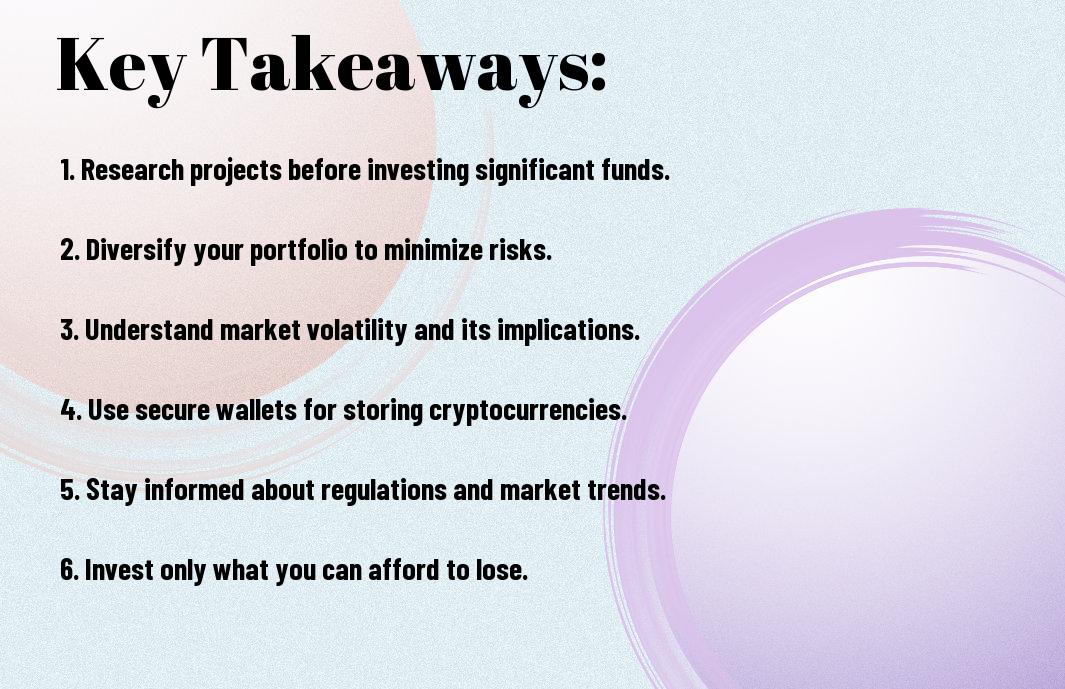Basics of cryptocurrency investing involve understanding key principles that can shape your financial future. As you navigate this dynamic landscape, it’s crucial to grasp concepts like blockchain technology, market volatility, and different types of cryptocurrencies. With the right knowledge, you can make informed decisions that align with your investment goals. This guide aims to equip you with the foundational insights needed to begin on your cryptocurrency journey confidently.
Key Takeaways:
- Research: Thoroughly investigate different cryptocurrencies and their underlying technologies before investing.
- Diversification: Spread your investments across various assets to mitigate risks associated with market volatility.
- Market Trends: Stay informed about market trends and news that can impact cryptocurrency values.
- Long-Term Perspective: Consider a long-term investment strategy, as cryptocurrency markets can be highly volatile in the short term.
- Security Measures: Implement strong security practices, such as using hardware wallets and enabling two-factor authentication, to protect your investments.

Understanding Cryptocurrency
Before stepping into cryptocurrency investing, it’s necessary for you to grasp the foundational concepts behind these digital assets. Understanding how cryptocurrencies function will empower you to make informed investment decisions and evaluate the risks and opportunities in this evolving market.
What is Cryptocurrency?
What you need to know is that cryptocurrency is a form of digital or virtual currency that relies on cryptography for secure transactions. Unlike traditional currencies issued by governments, cryptocurrencies operate on decentralized networks based on blockchain technology, allowing for transparent and tamper-proof record-keeping.
History and Evolution of Cryptocurrency
Against this backdrop, the history of cryptocurrency began with the introduction of Bitcoin in 2009. Created by an anonymous individual or group under the pseudonym Satoshi Nakamoto, Bitcoin was designed as a response to the financial system’s inefficiencies and the need for a new form of money. Over the years, thousands of alternative cryptocurrencies, or altcoins, have emerged, each varying in technology, purpose, and market potential.
With the rise of Bitcoin, the evolving landscape has witnessed significant innovations, including smart contracts and decentralized finance (DeFi). You can trace this journey through milestones such as the launch of Ethereum in 2015, which introduced programmable transactions, broadening the scope of cryptocurrency beyond simple payments. As you explore the history and evolution of this digital frontier, you’ll gain valuable insight into its potential and pitfalls, helping you navigate your way through cryptocurrency investing.
Types of Cryptocurrencies
There’s a diverse landscape of cryptocurrencies, each serving unique purposes and catering to different investor needs. Here’s a breakdown of some of the main categories:
- Bitcoin
- Major Altcoins
- Stablecoins
- Utility Tokens
- Security Tokens
The understanding of these categories can help you make informed decisions in your investment journey.
| Type | Description |
|---|---|
| Bitcoin | The original cryptocurrency, used as a digital gold. |
| Major Altcoins | Established cryptocurrencies like Ethereum and Ripple. |
| Stablecoins | Currencies pegged to stable assets like the USD. |
| Utility Tokens | Tokens used to access services or products. |
| Security Tokens | Blockchain representations of traditional securities. |
Bitcoin and Major Altcoins
Below are notable examples that any cryptocurrency investor should familiarize themselves with. Bitcoin leads the pack as the first and most recognized cryptocurrency, while major altcoins like Ethereum, Binance Coin, and Cardano offer innovative solutions and functionalities. By diversifying your portfolio including these leading cryptos, you can enhance both your potential returns and reduce risk.
Emerging Tokens and Projects
Below are some exciting new entrants in the cryptocurrency market that could potentially reshape the landscape. Emerging tokens focus on niche markets, innovative technologies, or groundbreaking ideas, often attracting tech-savvy investors looking for fresh opportunities.
Major emerging tokens are those that tackle unique problems or enhance existing technologies, like DeFi platforms or NFTs, often drawing significant attention. By researching these projects thoroughly, including their whitepapers and community engagement, you can identify promising opportunities that align with your investment strategy.

How to Start Investing in Cryptocurrency
Despite the complexities surrounding cryptocurrency, starting your investment journey can be quite straightforward. Begin by educating yourself on the basics and strategies involved. You may find helpful resources like Start Investing In Cryptocurrency: A Guide for Newcomers …. Once you have a solid foundation, you can confidently explore the world of digital assets.
Choosing the Right Exchange
Any final choice of exchange can significantly affect your trading experience. Consider factors such as security, fees, and available cryptocurrencies when making a decision. Look for exchanges that have a good reputation and customer reviews, ensuring your investments are kept safe.
Setting Up a Wallet
Choosing the right wallet is imperative for securing your cryptocurrency. Options include hardware wallets, which offer high security, or software wallets, which are more accessible for frequent trading. Assess your investment style to find the best fit, keeping in mind that you’ll need to manage keys securely.
Also, take the time to explore the features of different wallets. Some wallets offer enhanced security measures, ease of use, and even built-in trading functionalities. Ensure you research and select a wallet compatible with the cryptocurrencies you wish to invest in. Storing your digital assets wisely is vital for safeguarding your investments over time.
Analyzing Cryptocurrency Investments
Unlike traditional investments, analyzing cryptocurrencies requires a multi-faceted approach. Due to the market’s volatility and unique factors influencing prices, you need to employ various analytical methods to obtain a comprehensive understanding of potential investments. This includes evaluating both the underlying fundamentals and the price charts to make informed decisions.
Fundamental Analysis
Among the various techniques available, fundamental analysis focuses on evaluating the intrinsic value of a cryptocurrency. You assess factors such as the technology behind the coin, the project’s team, market demand, partnerships, and regulatory environment to establish whether a cryptocurrency is undervalued or overvalued.
Technical Analysis
Before stepping into specific cryptocurrencies, you should familiarize yourself with technical analysis, which involves studying historical price data and trading patterns. This approach allows you to identify trends, support and resistance levels, and potential entry or exit points for your investments.
Fundamental analysis lays the groundwork for understanding the overall health of a cryptocurrency project, while technical analysis offers insight into market timing. By combining both methods, you enable yourself to make data-driven decisions based on the project’s potential and current market conditions. This dual approach can significantly enhance your investment strategy, helping you maximize returns and minimize risks.
Risks and Challenges of Cryptocurrency Investing
Keep in mind that cryptocurrency investing carries significant risks and challenges. Market fluctuation, cyber threats, and regulatory changes can impact your investments. It’s wise to educate yourself first; consider exploring Cryptocurrency Basics: Pros, Cons and How It Works for a better understanding of the landscape.
Market Volatility
Any cryptocurrency investment you consider is subject to market volatility. Prices can swing dramatically in short periods, leading to potential gains or losses. Therefore, it’s important to stay informed about market trends and analyze how various factors influence the value of your investments.
Security Concerns
After plunging into cryptocurrency, you’ll encounter several security concerns that warrant your attention. Cyberattacks, hacking incidents, and frauds frequently target investors and exchanges, putting your assets at risk. Ensuring you use secure wallets and trusted platforms can help mitigate this threat.
Hence, prioritizing security measures is vital for safeguarding your investments. Always opt for hardware wallets when storing large amounts of cryptocurrency and enable two-factor authentication on exchanges and wallets. Regularly monitoring your accounts and being vigilant against potential phishing attacks can enhance your protection further, allowing you to invest with confidence.
Strategies for Successful Investing
For anyone venturing into cryptocurrency, having a well-thought-out investment strategy can significantly enhance your chances of success. You should consider different approaches based on your individual financial goals and risk tolerance. Whether you prefer long-term holdings or are interested in short-term trading, developing a clear strategy tailored to your situation will help you navigate the volatile crypto market more effectively.
Long-term vs. Short-term Investment
Across the cryptocurrency landscape, investors often wrestle with the decision between long-term and short-term investments. While long-term investing focuses on holding assets for extended periods to capitalize on potential growth, short-term trading looks to leverage market fluctuations for quick profits. Your choice should align with your investment objectives, risk acceptance, and market understanding.
Diversification and Risk Management
Investing in multiple assets can help mitigate risks associated with market volatility. You should aim to spread your investments across various cryptocurrencies and related sectors, allowing for more balanced portfolio growth. By diversifying, you reduce the impact of a poor-performing asset on your overall portfolio.
Understanding how to effectively manage your investment risks is important when entering the world of cryptocurrencies. A diversified portfolio not only lowers potential losses but provides opportunities for gains across different assets. Ideally, you should include a mix of established cryptocurrencies and promising altcoins to enhance your exposure to market movements while maintaining a balanced risk profile. Additionally, regular portfolio reviews will enable you to adjust your holdings and respond proactively to market changes.
Conclusion
To wrap up, understanding the basics of cryptocurrency investing is necessary for your journey into this dynamic financial landscape. By familiarizing yourself with key concepts like blockchain technology, wallet types, and market analysis, you can make informed decisions that align with your investment goals. Stay updated on industry trends, practice risk management, and consider diversifying your portfolio. With diligence and education, you can navigate the cryptocurrency market with confidence and potentially unlock new opportunities for wealth growth.
Q: What is cryptocurrency and how does it work?
A: Cryptocurrency is a digital or virtual form of currency that uses cryptography for security. It operates on a technology called blockchain, which is a decentralized ledger that records all transactions across a network of computers. This decentralization ensures that no single entity has control, making cryptocurrencies resistant to fraud and manipulation. Transactions are verified by network nodes through cryptography and recorded in the blockchain, allowing for transparency and security in financial exchanges.
Q: How do I start investing in cryptocurrencies?
A: To start investing in cryptocurrencies, first, educate yourself about different types of cryptocurrencies available in the market, such as Bitcoin, Ethereum, and many others. Next, choose a reliable cryptocurrency exchange where you can create an account and purchase your desired cryptocurrencies. It’s imperative to set up a secure wallet to store your investments. You should also consider how much you want to invest and devise a strategy based on your risk tolerance and investment goals, whether you plan to hold long-term, trade frequently, or a combination of both.
Q: What are some risks associated with cryptocurrency investing?
A: Cryptocurrency investing comes with several risks that potential investors should be aware of. One significant risk is market volatility, where prices can fluctuate dramatically over short periods, leading to potential losses. There is also the risk of regulatory changes, as governments around the world are still formulating their policies regarding digital currencies. Additionally, the technology behind cryptocurrencies may face security vulnerabilities, and investors can fall victim to scams or cyberattacks. Therefore, it is important to stay informed and only invest what you can afford to lose.

